Last analysis expected support to hold, and it has.
Summary: Price is at support. For the short term, a new high above 1,327.81 and then above the yellow best fit channel would indicate an end to the downwards swing and the start of a new upwards swing.
The target is at 1,286 if the downwards swing continues.
The mid term picture still expects that Gold is within a B wave correction which may continue for several weeks.
Only a new low below 1,236.54 would signal a strong bear market for Gold.
New updates to this analysis are in bold.
Grand SuperCycle analysis is here.
Last in-depth historic analysis with monthly and several weekly charts is here, video is here.
There are multiple wave counts at this time at the weekly and monthly chart levels. In order to make this analysis manageable and accessible only two will be published on a daily basis, one bullish and one bearish. This does not mean the other possibilities may not be correct, only that publication of them all each day is too much to digest. At this stage, they do not diverge from the two possibilities below.
BULLISH ELLIOTT WAVE COUNT
FIRST WEEKLY CHART
Cycle wave b may be a single zigzag. Zigzags subdivide 5-3-5. Primary wave C must subdivide as a five wave structure and may be either an impulse or an ending diagonal. Overlapping at this stage indicates an ending diagonal.
Within an ending diagonal, all sub-waves must subdivide as zigzags. Intermediate wave (4) must overlap into intermediate wave (1) price territory. This diagonal is expanding: intermediate wave (3) is longer than intermediate wave (1) and intermediate wave (4) is longer than intermediate wave (2). Intermediate wave (5) must be longer than intermediate wave (3), so it must end above 1,398.41 where it would reach equality in length with intermediate wave (3).
Within the final zigzag of intermediate wave (5), minor wave B may not move beyond the start of minor wave A below 1,236.54.
Within intermediate wave (1), the correction labelled minor wave B was over within one week. Within intermediate wave (2), the correction labelled minor wave B was too quick to be seen on the weekly chart. Within intermediate wave (3), the correction labelled minor wave B was over in 12 weeks, one short of a Fibonacci 13. Within intermediate wave (4), the correction labelled minor wave B was over in a Fibonacci 8 weeks. As each actionary wave is extending in time as well as price, the correction of minor wave B within intermediate wave (5) may be longer than that within intermediate wave (3). At this early stage, a Fibonacci 13 or possibly even 21 weeks may be expected. This expectation is a rough guideline; flexibility is essential when B waves unfold.
This first weekly chart sees the upwards wave labelled primary wave A as a five wave structure. It must be acknowledged that this upwards wave looks better as a three than it does as a five. The fifth weekly chart below will consider the possibility that it was a three.
FIRST DAILY CHART
Within the ending diagonal, intermediate wave (5) must sub-divide as a zigzag.
Minor wave B may be a reasonably time consuming consolidation or a quicker sharper pullback within the upwards trend, and it may end about either of the 0.382 or 0.618 Fibonacci ratios (neither may be favoured).
There are more than 23 possible structures that minor wave B may take, and it is impossible until close to or at the end to have confidence which structure has unfolded. When B waves unfold, it is essential that analysis is flexible. B waves are analogous to either range bound consolidations or sharp corrections. As minor wave B unfolds, the labelling on the hourly chart for its sub-waves will change and alternates will be required from time to time.
The yellow arrow outlines the possible pathway for a flat or combination. These corrections are analogous to sideways range bound consolidations. Within both a flat and consolidation, minute wave b or x may make a new high above the start of minute wave a or w at 1,365.68.
Minor wave B may still be a triangle or zigzag. All possibilities must still be considered.
Minor wave B may not move beyond the start of minor wave A below 1,236.54.
HOURLY CHART
Classic technical analysis still favours this first hourly chart.
A zigzag downwards may be complete, which may be minute wave a. Within the zigzag, there is an excellent Fibonacci ratio between minuette waves (a) and (c).
If minute wave a has subdivided as a zigzag, then minor wave B may be any one of either a flat, triangle, combination or double zigzag.
Within flats and combinations, minute wave b or x may be very deep. Within a flat correction, minute wave b must retrace a minimum 0.9 length of minute wave a.
Within a triangle, there is no minimum requirement for minute wave b, but it does need to subdivide as a three wave structure.
All of a flat, combination or triangle would see price continue to find support here about 1,310 to 1,305, at least for the short to mid term.
Within a double zigzag, minute wave x should be relatively brief and shallow. (Note: A double zigzag would not follow the pathway of the yellow arrow here.)
Within all the possible corrective structures that may continue for minor wave B, the next upwards wave for minute wave b or x should exhibit internal weakness. B waves often have light volume and at their extremes exhibit divergence between price and indicators.
Downwards movement during Friday’s session is very choppy and overlapping. This action looks corrective and supports this wave count.
ALTERNATE HOURLY CHART
An impulse downwards may be continuing. This may be minute wave a within a zigzag for minute wave b.
The middle of the impulse may have passed. If this is correct, then subminuette wave iv may now not move into subminuette wave i price territory above 1,327.81.
When minute wave a completes, then minute wave b should unfold. Minute wave b may be a quick sharp bounce, or it may be a very complicated time consuming sideways movement. It may not move beyond the start of minute wave a.
The final target for minor wave B for this wave count would now most likely be the 0.618 Fibonacci ratio of minor wave A at 1,286.
SECOND ALTERNATE HOURLY CHART
If a zigzag downwards is complete, then the possibility that minor wave B may be over in its entirety must be considered.
If price makes a new high above 1,327.81 and breaks above the yellow channel, then both the first hourly chart and this second alternate hourly chart will be valid.
If upwards movement shows strength, then this wave count may be favoured.
BEARISH ELLIOTT WAVE COUNT
FIFTH WEEKLY CHART
There were five weekly charts published in the last historic analysis. This fifth weekly chart is the most immediately bearish wave count, so this is published as a bearish possibility.
This fifth weekly chart sees cycle wave b as a flat correction, and within it intermediate wave (B) may be a complete triple zigzag. This would indicate a regular flat as intermediate wave (B) is less than 1.05 the length of intermediate wave (A).
If cycle wave b is a flat correction, then within it primary wave B must retrace a minimum 0.9 length of primary wave A at 1,079.13 or below. The most common length of B waves within flats is from 1 to 1.38 times the length of the A wave. The target calculated would see primary wave B end within this range.
I have only seen two triple zigzags before during my 10 years of daily Elliott wave analysis. If this wave count turns out to be correct, this would be the third. The rarity of this structure is identified on the chart.
TECHNICAL ANALYSIS
WEEKLY CHART
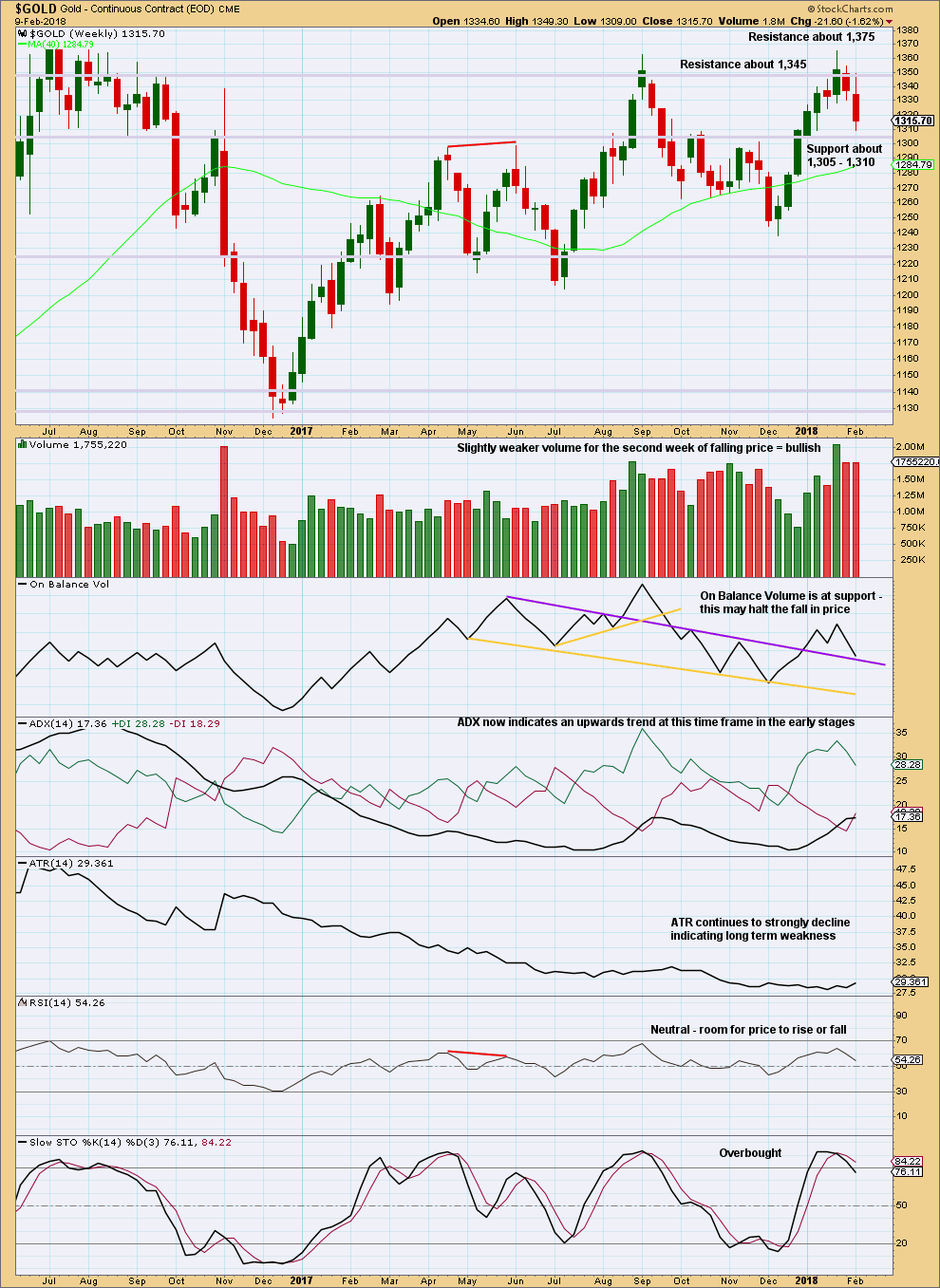
Click chart to enlarge. Chart courtesy of StockCharts.com.
Support for price about 1,310 – 1,305 and support for On Balance Volume may halt the fall in price here.
However, RSI and Stochastics indicate there is plenty of room for price to fall further. If support about 1,310 – 1,305 gives way, then next support is about 1,225.
A breakout above 1,375 on a day with strong volume would have to occur for the bullish case to have strong confidence.
DAILY CHART
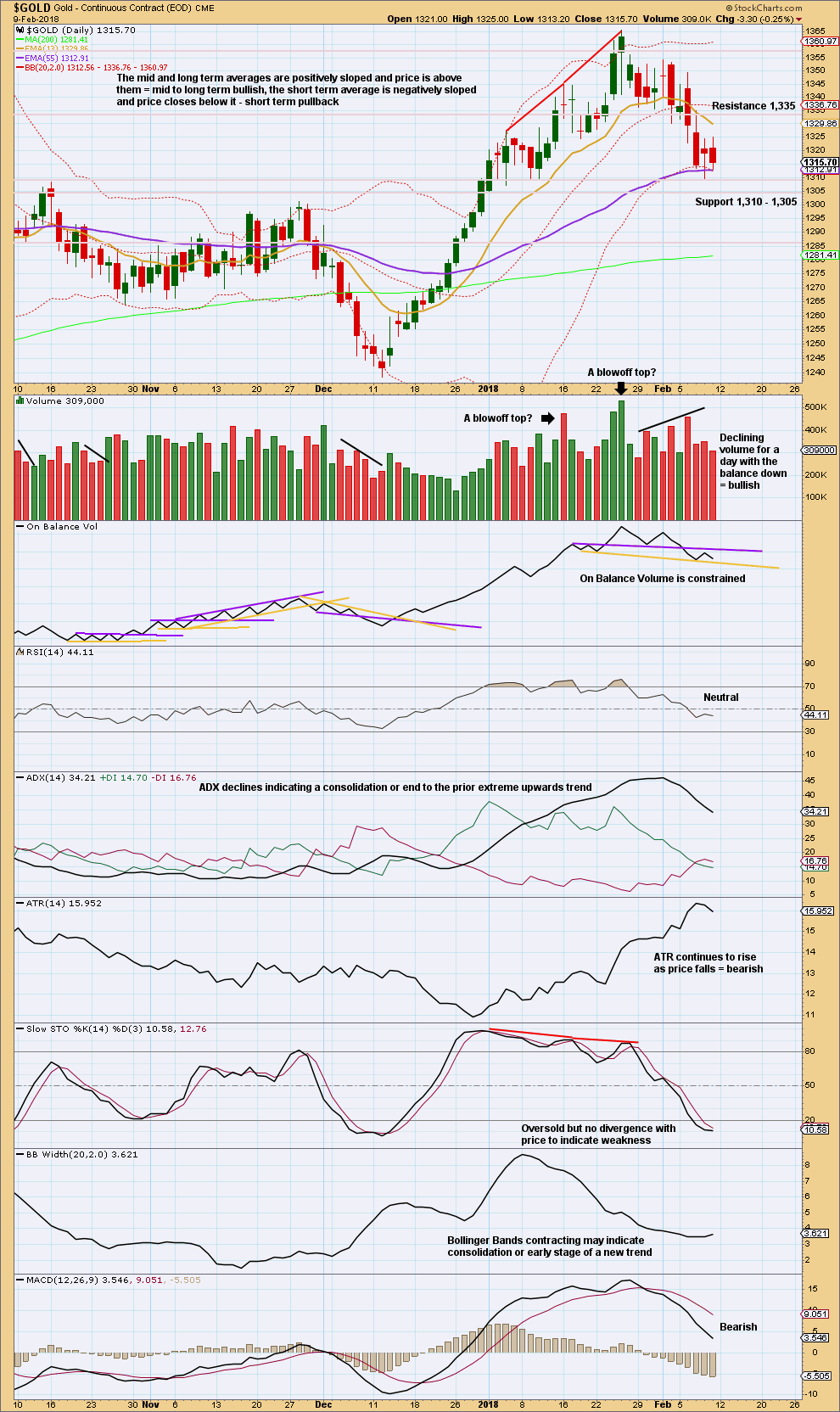
Click chart to enlarge. Chart courtesy of StockCharts.com.
Price is at support and On Balance Volume is close to support. With Stochastics oversold and price at support, it is reasonable still to expect an end to the downwards swing about here.
GDX WEEKLY CHART
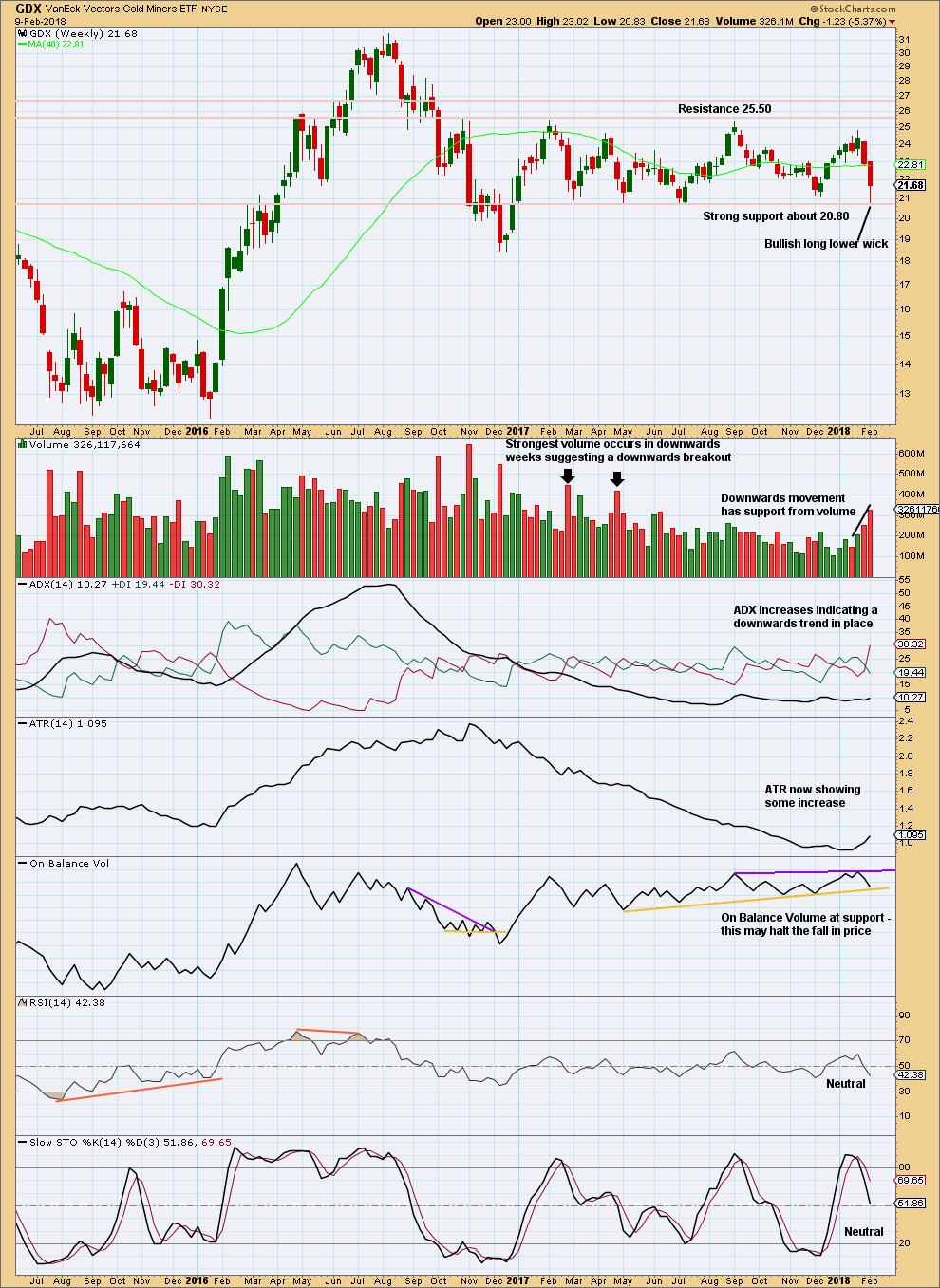
Click chart to enlarge. Chart courtesy of StockCharts.com.
Support about 20.80 has been tested at least five times and so far has held. The more often a support area is tested and holds, the more technical significance it has.
In the first instance, expect this area to continue to provide support. Only a strong downwards day, closing below support and preferably with some increase in volume, would constitute a downwards breakout from the consolidation that GDX has been in for a year now.
Resistance is about 25.50. Only a strong upwards day, closing above resistance and with support from volume, would constitute an upwards breakout.
The long lower wick this week is fairly bullish. Look for an upwards swing now to resistance.
GDX DAILY CHART
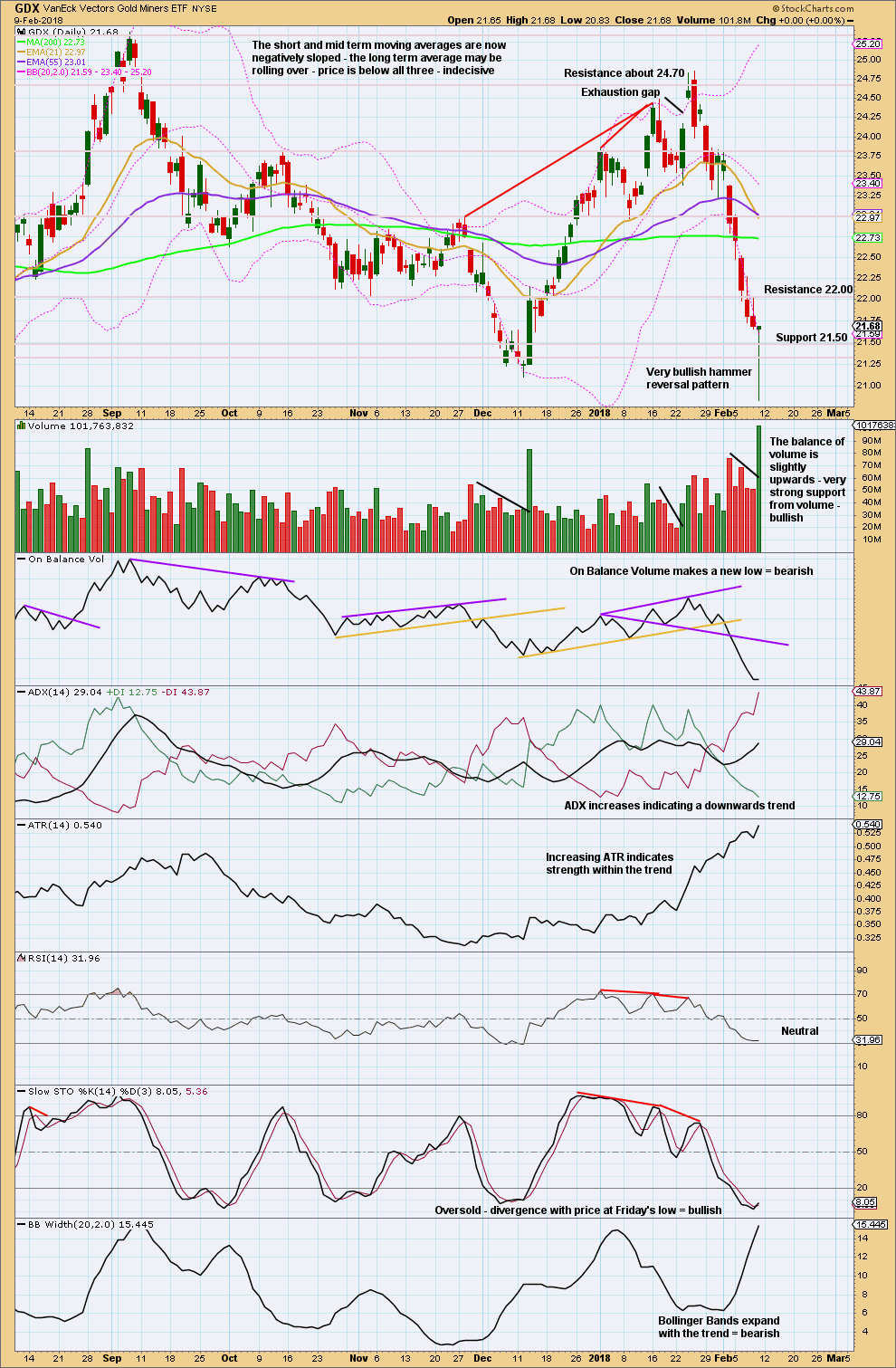
Click chart to enlarge. Chart courtesy of StockCharts.com.
The strong long lower wick and support from volume indicate upwards movement next week for GDX.
Published @ 09:21 p.m. EST on 10th February, 2018.

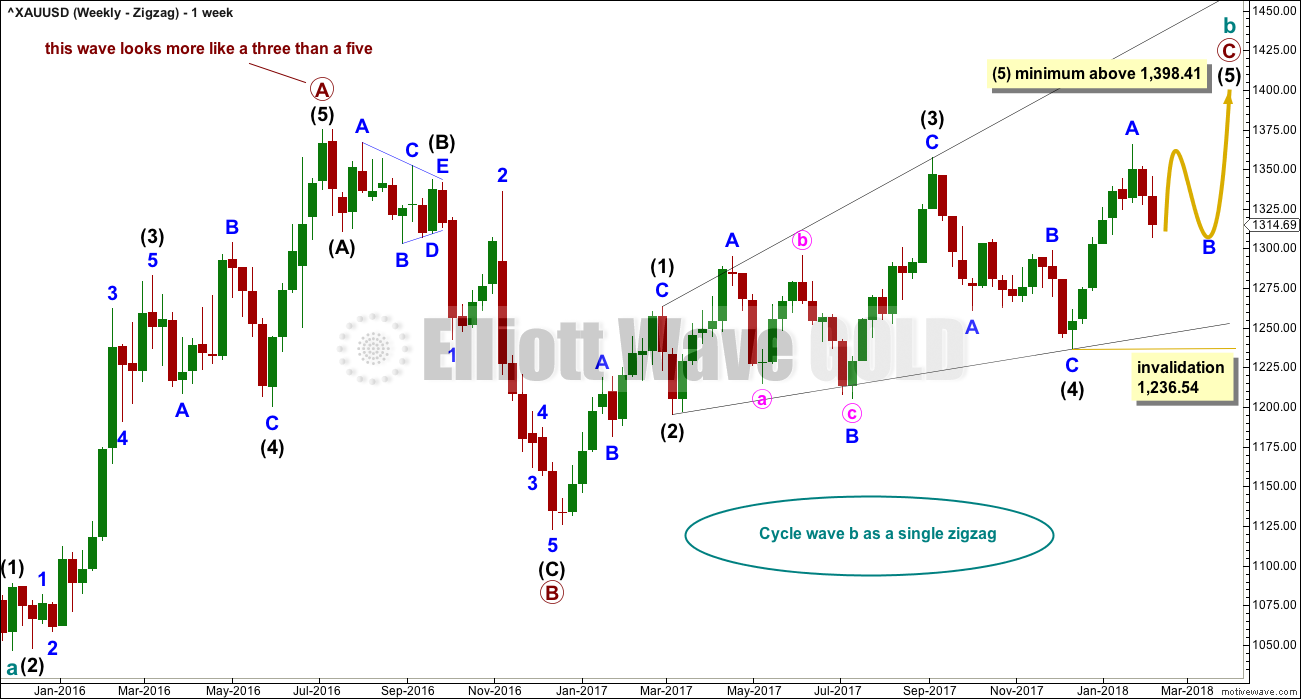
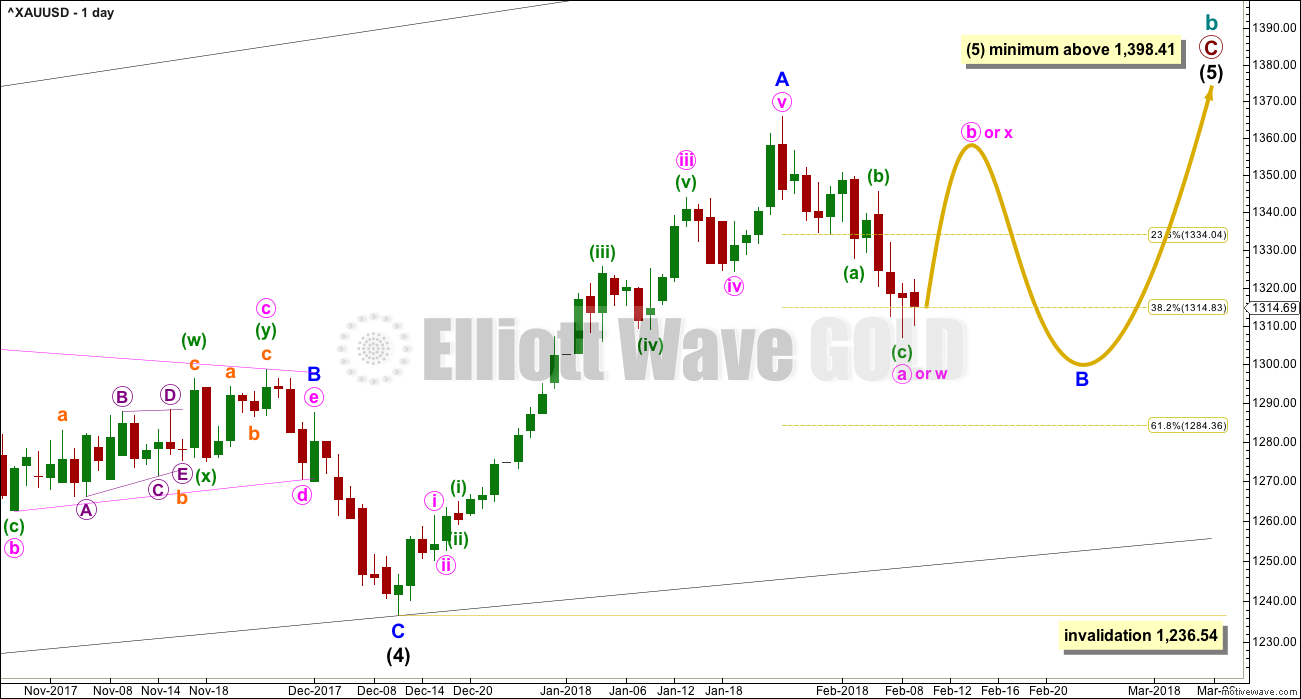
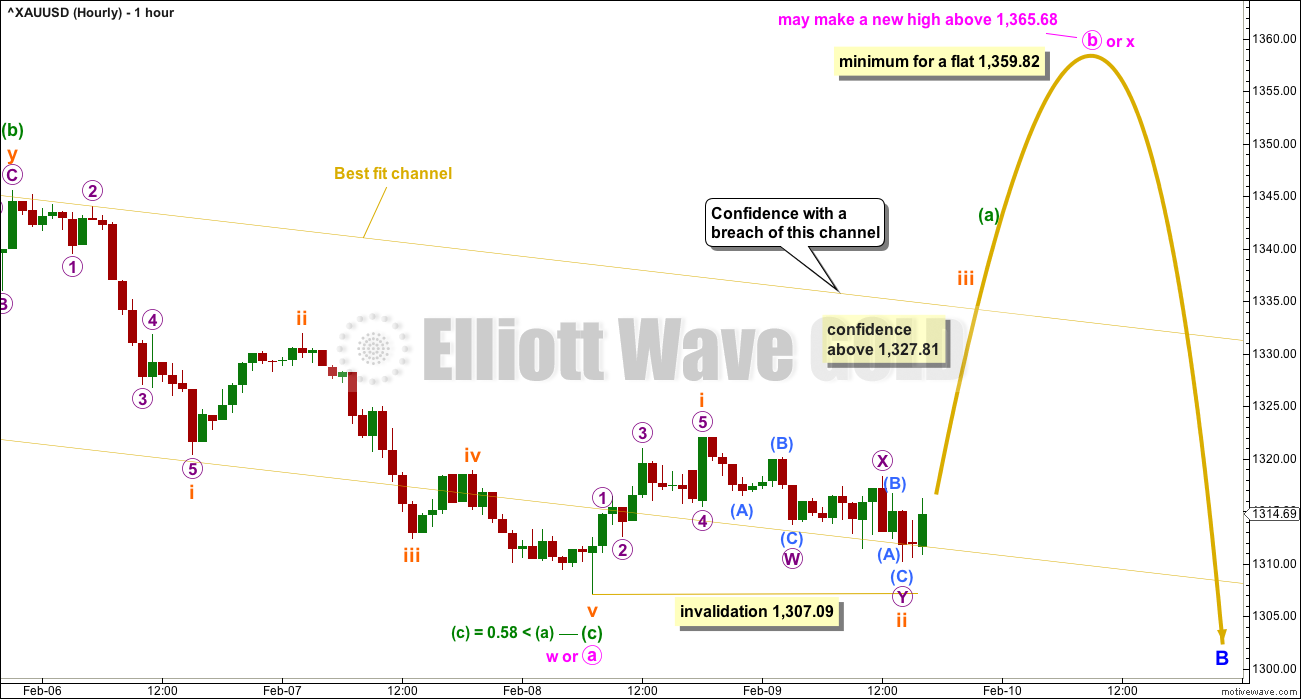
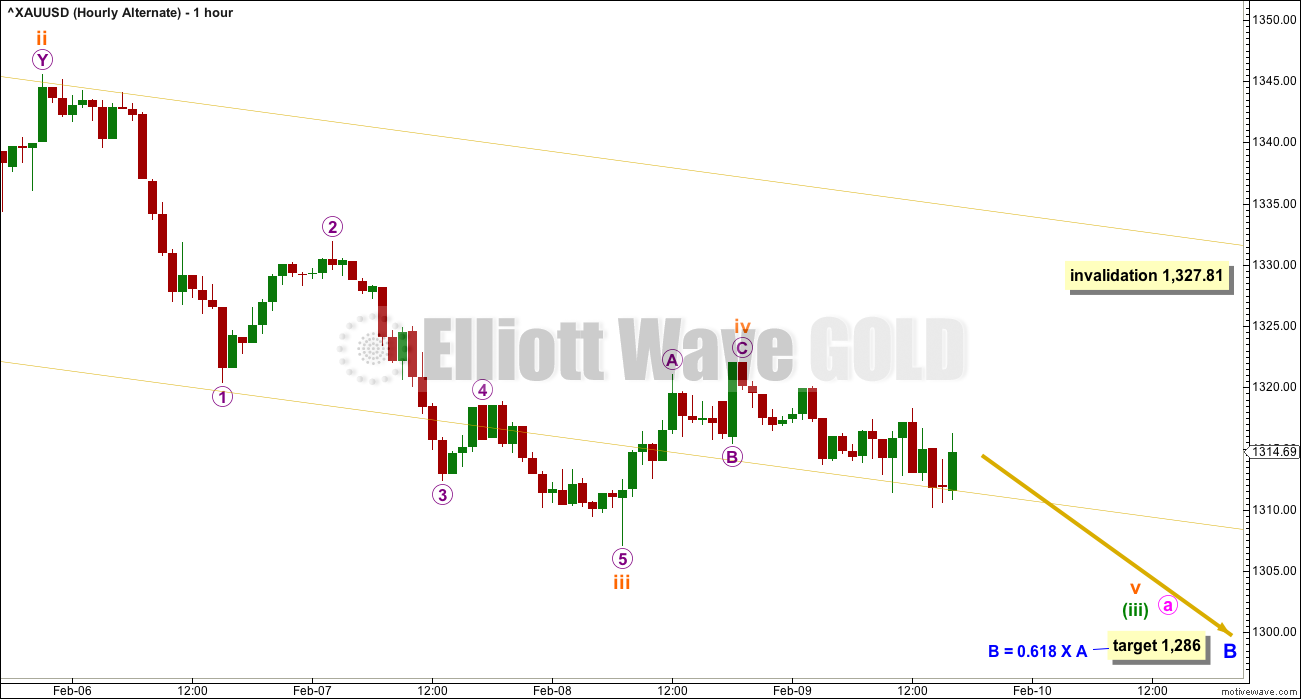
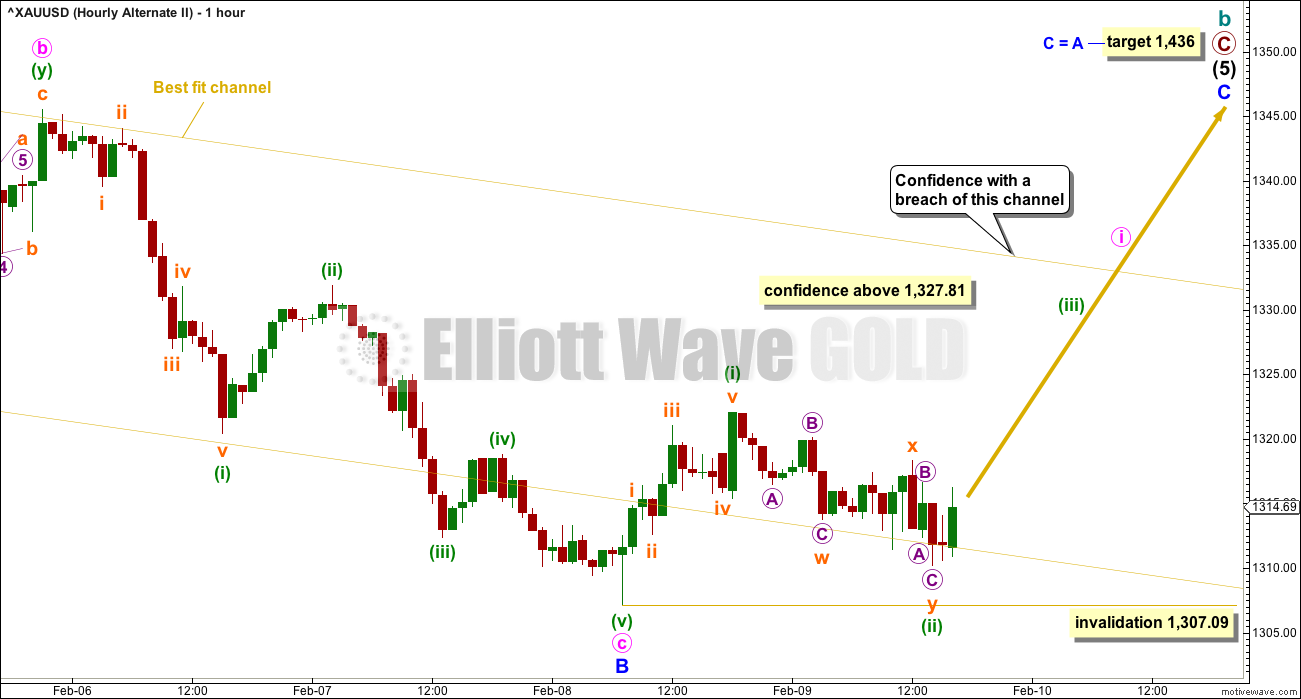
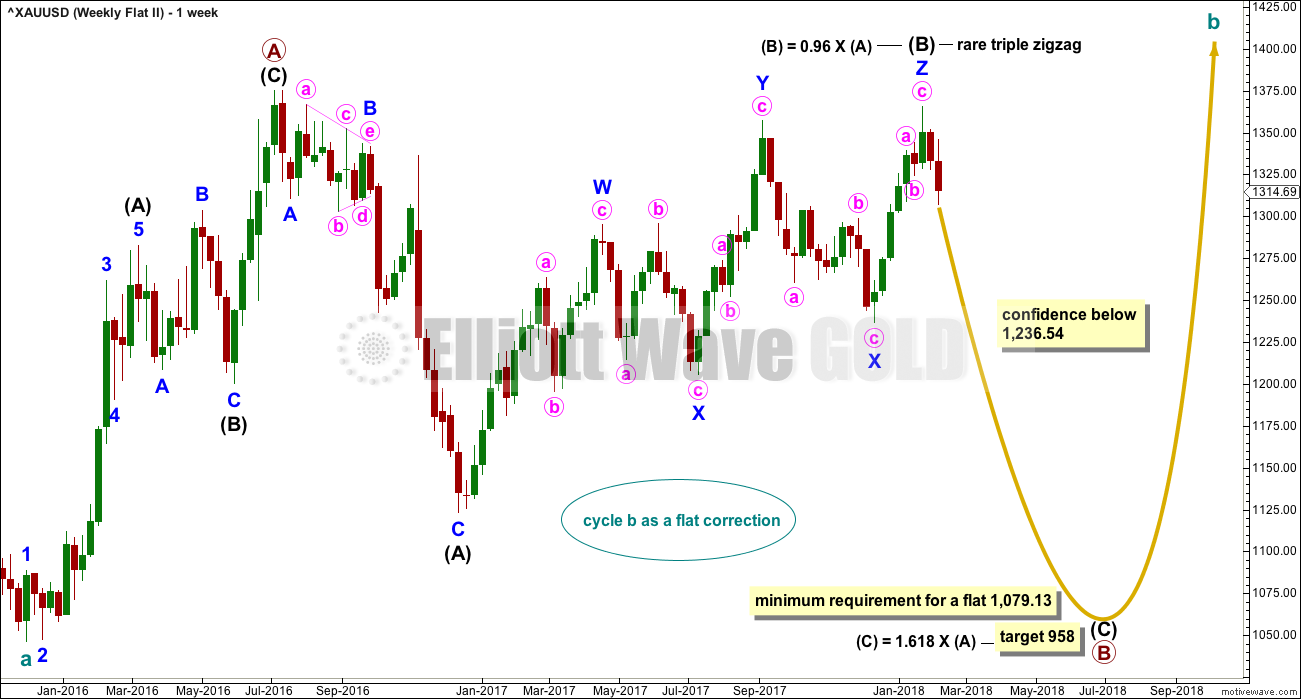
Alternate hourly updated:
There is now no alternation in structure between subminuette waves ii and iv; both are double zigzags. This reduces the probability of this wave count.
Invalidation point remains the same.
First hourly chart updated:
No confidence points breached yet and price is still within the channel.
The triangle posted earlier in the week for GDXJ still looks good and it must be complete now. Expect a strong move up now if this is correct.
https://www.tradingview.com/x/nnFo2wAJ/
Lara, you noted that GDX looks bullish on your TA analysis. I agree. The bullish hammer on high volume looks like it may be a key reversal point.
The spike down on Friday before the reversal invalidated my GDX triangle posted earlier in the week. While it still looks like a symmetrical triangle, I no longer see an EW triangle at this point.
The long consolidation now looks like some kind of sideways combination that may be complete. I come up with a sideways DZZ for Primary B of Cycle y. Not sure if there is a better way to label this?
Anyway, we may get an explosive move up from this point.
https://www.tradingview.com/x/AgLJ4gjt/
I’ll take some time later today to try and figure out my own count for GDX. Yours fits and meets all EW rules, and so far I can’t see a better option, but I’m not happy with double ZZs that just move sideways. I’ll look to see if there could be a flat in there which would then explain all the sideways look.
But yeah, that spike down on Friday invalidated an EW triangle sadly.
That’s what happens though isn’t it. You have a triangle count, looks perfect, may even look complete, only for it to be invalidated and turn out to be some kind of complicated combination. Ugh. All. The. Time.
Most frustrating triangles. Which is why it’s important to be flexible and have alternates when you think you see a triangle unfolding.
Yep, I really dislike large triangles. So frustrating. I agree on the sideways DZZ as I thought most extend the correction much deeper, not just extent the time with sideways movement and then a slight new low.
I also don’t really like the W-X-Y that I show for minor B of Intermediate Y. It has a really deep X wave. I tried looking for a Flat somewhere in the overall sideways structure of Primary B and couldn’t find one. May be you will. Thanks,
Well, if you’ve looked and couldn’t find it, then it’s probably not there.
I’ll take a look, but I’m not liking my chances 🙂